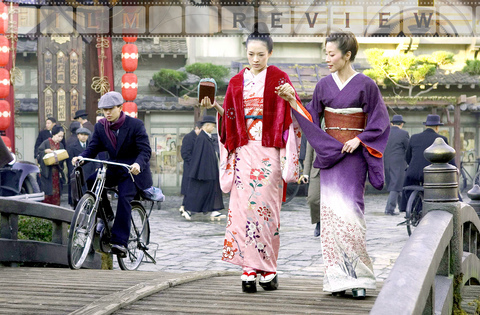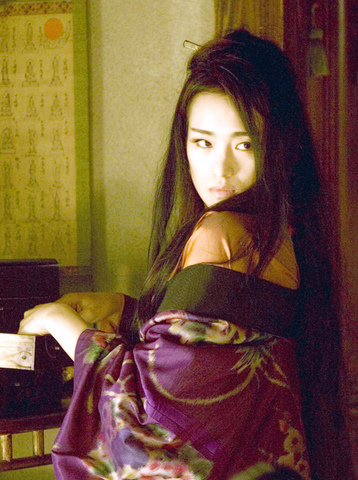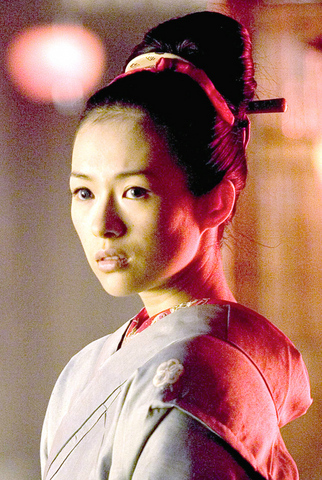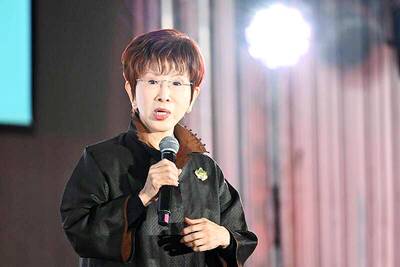Swathed in silk and longing (mostly for a bald guy called Oscar), the big-screen version of Memoirs of a Geisha arrives with good intentions firmly in place. Based on the bestseller by Arthur Golden, this lavishly appointed melodrama was directed by Rob Marshall, lately of Chicago, and features the Chinese superstars Zhang Ziyi (章子怡) and Gong Li (鞏俐), and the Malaysian transplant Michelle Yeoh (楊紫瓊), as Japanese geishas swept up in jealous rivalries during the 1930s and 1940s. In this cloistered world, men come and go as do history and warplanes, amid spectacularly unfortunate metaphors about male eels and female caves and one regrettably brief catfight in a kimono.
That catfight happens late in the story, long after Zhang's character, a geisha named Sayuri, has realized that the greatest obstacle to her happiness is an older star geisha, Hatsumomo (Gong). Sold to a geisha household, or okiya, as a child, Sayuri has long lived under the same roof as Hatsumomo, first as a prepubescent slave and then as a fully ripe rival. With her eye for beauty, Hatsumomo plots her challenger's demise with a ferocity that brings to mind both Joan Crawford and the Crawford impressionist Faye Dunaway in all their nostril-flaring, no-wire-hangers intensity. Clare Boothe Luce, who wrote The Women, a poison-pen letter to her sex that became one of Crawford's more famous and least agreeable vehicles, would have approved.
Originally published in 1997, Golden's celebrated venture into higher-end chick lit centers on Sayuri, who survives a childhood of suffering to become a famous entertainer. Narrated in the first person, the book is em`broidered with vaguely ethnographic exotica, Japanese words and phrases and a great deal of hothouse intrigue about who did what to whom and where. To the non-Japanese eye, the life of the geisha may appear intoxicatingly exotic, perfumed with face powder and the suggestion of sex, but at least in the film, which is credited to the screenwriter Robin Swicord, the whole thing plays out like "As the Okiya Turns," complete with devious rivals, swoonworthy swains,

PHOTOS: AP
fabulous accouterments, a jaw-dropping dance number recycled from Madonna's Drowned World tour and much clinching, panting and scheming.
Then again, there isn't all that much for a geisha to do other than serve and conspire. Rigorously trained from childhood, geishas dedicate themselves wholly to the paid amusement of male customers. Once upon a time in Japan, some women were in the service of procreation, others were employed for recreational sex, while the geisha operated in that gray area in between. (Curiously, the first geishas were men.) Geishas aren't typical sex workers; they're super-classy sex workers who sell their virginity to the highest bidder (the pretext in both the book and film for that unhappy bit about eels and caves) and rely on steady male patronage. But while serving a new customer every six months certainly sounds less untoward than, say, turning six tricks a night in a day-rate motel, who's kidding whom?
The book and the film attempt to attenuate the more distasteful aspects of geisha life, mostly by avoiding the contradiction between its degradations and its glamorous trappings. The story, after all, opens in the 1920s with the young Sayuri, then called Chiyo, (Suzuka Ohgo), then a nine-year-old, and her older sister being sold by their impoverished fisherman father and spirited away into the dark, rainy night. The girls are soon separated, with the older sister sold to a low-end brothel and the future geisha sold to her okiya, a beehive of female activity run by a pair of crones cum pimps and supported by the labor of its clipped-wing queen, Hatsu-momo. Legally bound to the crones, to whom she must hand over most of her wages, Hatsumomo hopes to secure her future by one day running the okiya.

PHOTO: AP
The exquisite Gong looks like a gift that keeps on giving when trussed up in silk, but she and the film come most alive when her hair tumbles down and she sashays about the okiya, stirring the air with her tremulous rage. Having seen a very different future for herself in the gray eyes of the new girl, Hatsumomo directs all that fury toward her eradication. In time, this enmity will assume soap-operatic proportions and involve the rival geisha Mameha (Yeoh), who takes Sayuri on as a trainee, and the two businessmen whose attentions consume so much of the women's and the story's time: the Chairman (Ken Watanabe, the majestic hunk from The Last Samurai) and his partner and friend, Nobu (the great Japanese actor Koji Yakusho).
Marshall can't rescue the film from its embarrassing screenplay or its awkward Chinese-Japanese-Hollywood culture klatch, but Memoirs of a Geisha is one of those bad Hollywood films that by virtue of their production values nonetheless afford a few dividends, in this case, fabulous clothes and three eminently watchable female leads.
Although there are moments when Hatsumomo comes perilously close to Dragon Lady caricature ("I will destroy you!"), the actress' talent and dignity keep the performance from sliding into full-blown camp. But even the formidable Gong cannot surmount the ruinous decision to have her and Zhang, along with the poorly used Yakusho, deliver their lines in vaguely British-sounding English that imparts an unnatural halting quality to much of their dialogue. The. Result. Is. That. Each. Word. Of. Dialogue. Sounds. As. If. It. Were. Punctuated. By. A. Full. Stop. Which. Robs. The.

PHOTO: AP
Language. Of. Its. Watery. Flow. And. Breath. Of. Real. Life. Even. As. It. Also. Gives. New. Meaning. To. The. Definition. Of. The. Period. Movie.

The low voter turnout for the referendum on Aug. 23 shows that many Taiwanese are apathetic about nuclear energy, but there are long-term energy stakes involved that the public needs to grasp Taiwan faces an energy trilemma: soaring AI-driven demand, pressure to cut carbon and reliance on fragile fuel imports. But the nuclear referendum on Aug. 23 showed how little this registered with voters, many of whom neither see the long game nor grasp the stakes. Volunteer referendum worker Vivian Chen (陳薇安) put it bluntly: “I’ve seen many people asking what they’re voting for when they arrive to vote. They cast their vote without even doing any research.” Imagine Taiwanese voters invited to a poker table. The bet looked simple — yes or no — yet most never showed. More than two-thirds of those

In the run-up to the referendum on re-opening Pingtung County’s Ma-anshan Nuclear Power Plant last month, the media inundated us with explainers. A favorite factoid of the international media, endlessly recycled, was that Taiwan has no energy reserves for a blockade, thus necessitating re-opening the nuclear plants. As presented by the Chinese-language CommonWealth Magazine, it runs: “According to the US Department of Commerce International Trade Administration, 97.73 percent of Taiwan’s energy is imported, and estimates are that Taiwan has only 11 days of reserves available in the event of a blockade.” This factoid is not an outright lie — that

Former Chinese Nationalist Party (KMT) chairwoman Hung Hsiu-chu’s (洪秀柱) attendance at the Chinese Communist Party’s (CPP) “Chinese People’s War of Resistance Against Japanese Aggression and the World Anti-Fascist War” parade in Beijing is infuriating, embarrassing and insulting to nearly everyone in Taiwan, and Taiwan’s friends and allies. She is also ripping off bandages and pouring salt into old wounds. In the process she managed to tie both the KMT and the Democratic Progressive Party (DPP) into uncomfortable knots. The KMT continues to honor their heroic fighters, who defended China against the invading Japanese Empire, which inflicted unimaginable horrors on the

Sitting on a bus bound for Heping Island (和平島), at the start of my first visit to Keelung in years, I was hell-bent on visiting a place of considerable historical interest, even though I knew that it wasn’t officially open to the public. In 2011, archaeologists working in the densely populated southern half of the island unearthed the foundations of the Convento de Todos los Santos (Convent of All Saints, 諸聖教堂), a Catholic house of worship established during Spain’s 1624-1642 occupation of northern Taiwan. I’d heard about its rediscovery a while ago, but it wasn’t until I read a scholarly